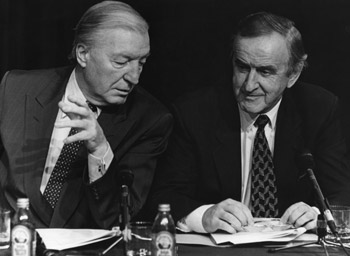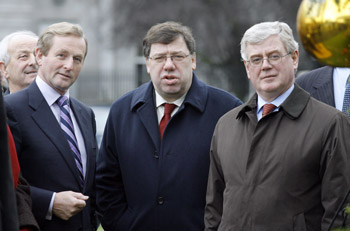Why life without Fianna Fail changes everything

Fianna Fáil’s removal as the largest party is likely to have far-reaching consequences for the entire Irish political system. Other parties could also find the new order will bring unpleasant shocks, writes DAN WHITE
11 June 2009
 While the results of the European and local elections and the twin Dublin by-elections were not available at the time this article went to press, there was, even before the country went to the polls, little doubt that Fianna Fáil would lose its position as Ireland’s largest political party.
While the results of the European and local elections and the twin Dublin by-elections were not available at the time this article went to press, there was, even before the country went to the polls, little doubt that Fianna Fáil would lose its position as Ireland’s largest political party.
To consider just how unprecedented this situation is one has only to cast one’s mind back to the last time it happened. One has to go all the way back to the general election of September 1927 for the last time Fianna Fáil failed to emerge from a national election as the largest political party.
Since then it has been Fianna Fáil all the way. From the moment it first entered government in March 1932 following the previous month’s general election, the party founded by Eamon de Valera from the debris of the defeated anti-Treaty faction in the 1922-3 Civil War has utterly dominated Irish politics.
Of the 77 years and three months that have elapsed since it first entered office, Fianna Fáil has been in government for 56 years and five months. That’s as near as makes no difference to five years out of every six.
Internationally very few political parties have been able to match Fianna Fáil’s durability in office. Parties as disparate and, in their day apparently as durable, such as the Russian Bolsheviks and the Italian Christian Democrats, have vanished from the scene. Only the Swedish Social Democrats, who like Fianna Fáil made their political breakthrough during the 1930s Great Depression, have been able to match the longevity of the Irish party.
That was before the earth-shattering events forecast for 5 June. By demoting Fianna Fáil from the number one slot it has held for almost 80 years, the voters will have radically and almost certainly irrevocably altered the nature of Irish politics.
The Fianna Fáil phenomenon
For most of its existence Fianna Fáil and its leaders have thought of the organisation as ‘the’ party rather than merely ‘a’ political party. While it might seem that quibbling over the use of the definite rather than the indefinite article is a case of splitting hairs, this distinction is in fact crucial to understanding the Fianna Fáil phenomenon.
Fianna Fáil sees itself as being a national movement, whose aspirations and interests are indistinguishable from those of the nation as a whole. While other political parties might represent narrow sectional interests, Fianna Fáil, according to this line of thinking, transcends such petty differences.
In recent years this notion of ‘Fianna Fáil as nation’ has gradually come under pressure. The party has failed to win a majority of the seats in any general election since 1977 while it was forced to abandon its ‘core value’ of no coalitions and enter into government with the PDs in 1989. Since then it has only been able to sustain itself in government through partnerships with other, smaller parties, first the PDs, then Labour, then the PDs again and now the Green Party.
This need to seek coalition partners has not affected Fianna Fáil’s ability to dominate Irish politics. During the 20 years since it first entered a coalition, Fianna Fáil has been in power for 17 years and six months. In fact, having been in power for seven eighths of the past 20 years, Fianna Fáil has done slightly better since it broke its taboo against coalition than when it adhered to its single-party government fetish.
However, the key to Fianna Fáil’s success has been its unchallenged status as Ireland’s largest political party. Even when it was out of office it was still the largest political party. The closest it came to losing the top slot was in the November 1982 election when Fine Gael came within five seats of its largest rival.
Until this month that is. Being so decisively knocked off its perch things could never be the same for Fianna Fáil and Irish politics again. While Fianna Fáil supporters have argued that losing number one position in local and European elections is in no way comparable to coming second, or even third, place in a Dáil election, this month’s elections almost certainly provide a fairly accurate indication of the result of the next general election.
Paying the price
Fianna Fáil is now paying the price for the worst economic downturn for almost 80 years. Having been in power for virtually all of the period since 1987 it can hardly blame the opposition for the economic and fiscal mess in which we now find ourselves.
The only question facing Fianna Fáil as it looks at the prospect of Armageddon at the next general election is whether ditching the hapless Brian Cowen and replacing him with a less economically tainted and more telegenic leader would reduce the scale of the likely losses and leave the party with a fighting chance of returning to office after the next-but-one general election.
It is if Fianna Fáil emerges from the next general election with much less than 50 seats that things start to get interesting. That would leave the party needing to win 40-plus seats at the following general election, almost certainly too steep a hill for even a party with Fianna Fail‘s vote-grabbing skills to climb.
Ever since it first entered office in 1932 Fianna Fáil has never been out of power after two consecutive general elections. This has meant that, as the “natural party of government,” it has always been able to rely on either the reality or imminent prospect of generous patronage in order to ease internal tensions and attract support.
Two or more terms on the opposition benches would remove these huge advantages. Removing the powerful political glue that patronage represents would also bring the ideological tensions which have always bubbled deep underground within Fianna Fáil bursting to the surface.
Fine Gael without its nemesis?
These factors mean that a sustained period out of office represents a potentially existential crisis for Fianna Fáil. At best it would find itself reduced to just one more medium-sized political party scrabbling for enough seats to qualify for membership of a multi-party coalition, at worst it could be wiped out altogether.
Before supporters of other political parties, particularly those of Fine Gael, grow too excited at the prospect of Fianna Fáil’s demise, they should think through the likely implications.
For most of the period since 1932, with the unfortunate exception of its brief dalliance with General Eoin O’Duffy’s fascist quasi-blueshirt movement from 1932 to 1934, Fine Gael has defined itself as the not-the-Fianna-Fáil-party. When the electorate finally tired of Fianna Fáil, Fine Gael would get an occasional turn in government before the natural political order reasserted itself.
If Fianna Fáil were to dramatically shrink in size or disappear altogether, where would that leave Fine Gael? Its fox would have been shot. Having spent almost 80 years defining itself against its hereditary enemy, Fine Gael would suddenly find itself without its unique selling point, being a slightly nicer, less crooked version of Fianna Fáil.
Fine Gael supporters should be careful what they wish for. They just might get it.



 Print
Print





Fans 0
Followers